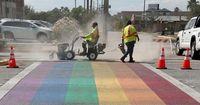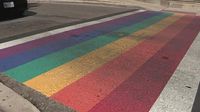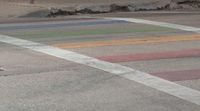In a move that has sparked heated debate across Texas, local governments are scrambling to respond to a sweeping new directive from Governor Greg Abbott that orders the removal of all roadway art installations deemed to convey political, social, or ideological messages—including the now-iconic rainbow Pride crosswalks and other community murals. The order, issued earlier this week, has already led to the removal of rainbow crosswalks in Galveston and prompted cities like Austin and Houston to announce their compliance, while others such as San Antonio are seeking further clarification before taking action.
According to The Chronicle, the controversy erupted on October 9, 2025, when city workers in Galveston began scraping away two rainbow crosswalks in front of City Hall. The city acted swiftly after Governor Abbott threatened to withhold state transportation funding from any municipality that failed to comply with federal roadway standards, as interpreted by the Texas Department of Transportation (TxDOT). The directive specifically targets symbols, flags, or markings that convey social, political, or ideological messages, a category that includes the rainbow crosswalks painted in 2019 to celebrate LGBTQ+ Pride.
"The City is aware of the new directive and will comply with updated guidelines," Austin officials said in a statement quoted by KXAN News on October 10, 2025. Austin, known for its vibrant public art scene, has several downtown crosswalks adorned with rainbow colors and a prominent mural in East Austin reading "Black Artists Matter." All of these installations are now slated for removal under the governor’s order.
In Houston, the Metropolitan Transit Authority (METRO) is preparing to remove the rainbow crosswalk at the busy intersection of Westheimer Road and Taft Street in the Montrose neighborhood—a hub for the city’s LGBTQ+ community. This comes just days after the city repainted the crosswalk, underscoring the suddenness and impact of the directive. METRO’s decision was confirmed by Spectrum News, which also reported that similar actions are expected in other Texas cities.
San Antonio, however, is taking a more cautious approach. Mayor Gina Ortiz Jones told Spectrum News that city officials are "awaiting additional information from TxDOT to ensure we understand the full scope of what may be impacted." She added, "As Mayor, I remain committed to balancing our community’s transportation needs with ensuring everyone in our community feels safe, welcomed, and supported." The city has decided to hold off on removing its rainbow crosswalks until it receives further clarification from state officials.
The governor’s order was prompted by a July 1 federal initiative known as the SAFE ROADS Initiative, announced by U.S. Transportation Secretary Sean Duffy. The initiative emphasizes that crosswalks and other roadway markings should be "kept free from distractions," prohibiting decorative elements such as murals or artwork unless they serve a direct traffic control or safety function. In a letter sent to city and county transportation officials, TxDOT cited the SAFE ROADS Initiative and warned that jurisdictions must "remedy any non-compliant installations within the next 30 days." Failure to comply, the letter warned, could result in the denial of state or federal funding, suspension of agreements with TxDOT, or the forced removal or modification of non-compliant markings on roads that are part of the state highway system or funded by TxDOT programs.
TxDOT Executive Director Marc Williams reiterated the urgency of the directive, stating that local governments have just 30 days to bring their streets into compliance or risk losing critical transportation dollars. The agency made clear that "pavement markings such as decorative crosswalks, murals, or markings conveying artwork or other messages are prohibited on travel lanes, shoulders, intersections, and crosswalks unless they serve a direct traffic control or safety function."
Supporters of the order argue that standardizing roadway markings is essential for safety and compliance with federal guidelines. They point to the SAFE ROADS Initiative’s focus on reducing distractions for both drivers and pedestrians. "State officials will be removing any symbols that do not serve to direct the flow of traffic," TxDOT confirmed, stating that this includes "any crosswalks and roadway markers with 'political ideology.'" According to Spectrum News, the push for uniformity is rooted in concerns that non-standard markings could confuse drivers or draw attention away from crucial traffic signals.
Yet the order has not gone unchallenged. Critics, including local LGBTQ+ advocates and artists, see the removal of rainbow crosswalks and community murals as an erasure of important symbols of diversity and inclusion. Many point out that these installations have become beloved landmarks and sources of civic pride. The directive’s reach is wide, sweeping up not only rainbow crosswalks but also murals like Austin’s "Black Artists Matter," raising concerns about the suppression of public art and community expression. Some city officials and residents argue that the order oversteps by targeting messages that foster a sense of belonging among marginalized groups.
The debate has also exposed divisions among Texas cities in how to interpret and respond to the order. Austin and Galveston have chosen to comply immediately, citing the risk of losing vital state transportation funding. In Galveston, city officials confirmed that the removal of the rainbow crosswalks was necessary to avoid jeopardizing support for local infrastructure projects. Meanwhile, San Antonio’s decision to wait for more guidance reflects the uncertainty many cities face in navigating the new rules—and the tension between upholding federal standards and honoring local values.
As for Houston’s Montrose neighborhood, the impending removal of its rainbow crosswalk is especially poignant. The intersection at Westheimer and Taft has long been a symbol of Houston’s LGBTQ+ community, and the crosswalk’s vibrant colors have drawn visitors and residents alike. The city had just repainted the crosswalk earlier in October, only to see it marked for removal days later. METRO’s compliance with the order is a sign of the pressure local agencies feel to align with state directives, even when it means dismantling cherished symbols.
The SAFE ROADS Initiative, while aimed at improving safety, has become a flashpoint in a broader cultural debate about the place of public art and the visibility of minority groups in Texas. The swift removal of crosswalks and murals has left many residents wondering what will become of the state’s tradition of using art to celebrate community identity and social progress. As cities weigh their next steps, the conversation is sure to continue—both on the streets and in city halls across Texas.
For now, the fate of Texas’s rainbow crosswalks and other roadway art installations hangs in the balance, with the clock ticking on a 30-day deadline that could reshape the look—and the spirit—of public spaces across the state.


